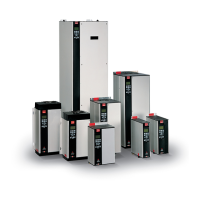VLT
®
5000 SyncPos option
MG.10.J4.02 – VLT is a registered Danfoss trade mark
34
Ten steps for optimum control
The following procedure will optimize your control-
ler settings in most applications:
1. Make sure that you have specified correct
values for VLT parameter #205, as well as the
SyncPos parameters VELMAX (1), ENCODER
(2) and RAMPMIN (31). If you change these
settings again at a later point you may need to
optimize the controller again.
2. Set the POSERR (15) parameter to a very high
value e.g. 1000000 to avoid getting the option
error no. 8 during the following tests.
NB!
To avoid damaging the system, make
sure, that you set the POSERR within the
limits of the system, because the position error
monitoring is not active with extremely high
values.
3. Optimize the
VV
VV
V
elocity feed-forwardelocity feed-forward
elocity feed-forwardelocity feed-forward
elocity feed-forward control:
Step 1)
Execute a "TESTRUN" with KPROP=0,
KDER=0, KINT=0, FFACC=0 and FFVEL=100.
Step 2)
View the velocity profiles: If the actual velocity
profile is lower than the setpoint velocity pro-
file, return to the TESTRUN dialog, click
"REPEAT" and increase FFVEL. Of course if
the actual velocity profile is higher than the
specified setpoint velocity you should de-
crease FFVEL.
Step 3)
Run successive TESTRUNs until the two velo-
city profiles shown in the TESTRUN graph
have the same maximum value.
Step 4)
FFVEL is now optimized, save the current
value.
4. In systems with large inertia and/or rapid
changes in the reference velocity it is a good
idea to use and optimize the
Acceleration feed-Acceleration feed-
Acceleration feed-Acceleration feed-
Acceleration feed-
forwardforward
forwardforward
forward control (make sure the inertial load is
connected when optimizing this parameter):
Step 1)
Execute a "TESTRUN" with KPROP=0,
KDER=0, KINT=0, FFACC=0 and FFVEL at the
optimized value found above. Use the highest
possible acceleration setting. If RAMPMIN (31)
is adjusted properly an acceleration value of
100 and a deceleration value of 100 should be
sufficient. Start out with a low setting of
FFACC approx. 10.
Step 2)
View the velocity profiles: If during accelera-
tion the actual velocity is constantly lower than
the reference velocity profile, then click
"REPEAT" and set a higher value of FFACC.
Then execute "TESTRUN" again.
Step 3)
Run successive TESTRUNs until the two velo-
city profiles shown in the TESTRUN graph
have similar ramp-up and ramp-down curves.
Step 4)
FFACC is now optimized, save the current
value.
5. Next step is finding the maximum stable value
of the
Proportional factoProportional facto
Proportional factoProportional facto
Proportional factor in the PID
controller:
Step 1)
Execute a "TESTRUN" with KPROP=0,
KDER=0, KINT=0. Set FFVEL and FFACC at
the optimized values found above.
Step 2)
View the velocity profile. If the velocity profile
isn't oscillating then click "REPEAT" and
increase KPROP.
Step 3)
Run successive TESTRUNs until the actual
velocity profiles is oscillating mildly.
Step 4)
Decrease this "mildly" unstable KPROP value
to about 70 %. Save this new value.
6. In order to dampen the oscillations created by
the KPROP-part of the controller, the
Derivative factorDerivative factor
Derivative factorDerivative factor
Derivative factor should now be optimized.
Step 1)
Execute a "TESTRUN" with KINT=0 and
KDER=200. Set FFVEL, FFACC and KPROP at
the optimized values found above.
Step 2)
Run successive TESTRUNs with increasing
values of the KDER factor. At first the oscilla-
tions will gradually reduce. Stop increasing
KDER when the oscillations begin to increase.
Step 3)
Save the last value of KDER.
7. In any system that requires a zero steady-state
error, the integration part of the controller must
be used. Setting this parameter though is a
trade-off between achieving zero steady-state
error fast (which is good) and increasing over-
shoot and oscillations in the system (which is
bad).
Optimizing the PID controller
